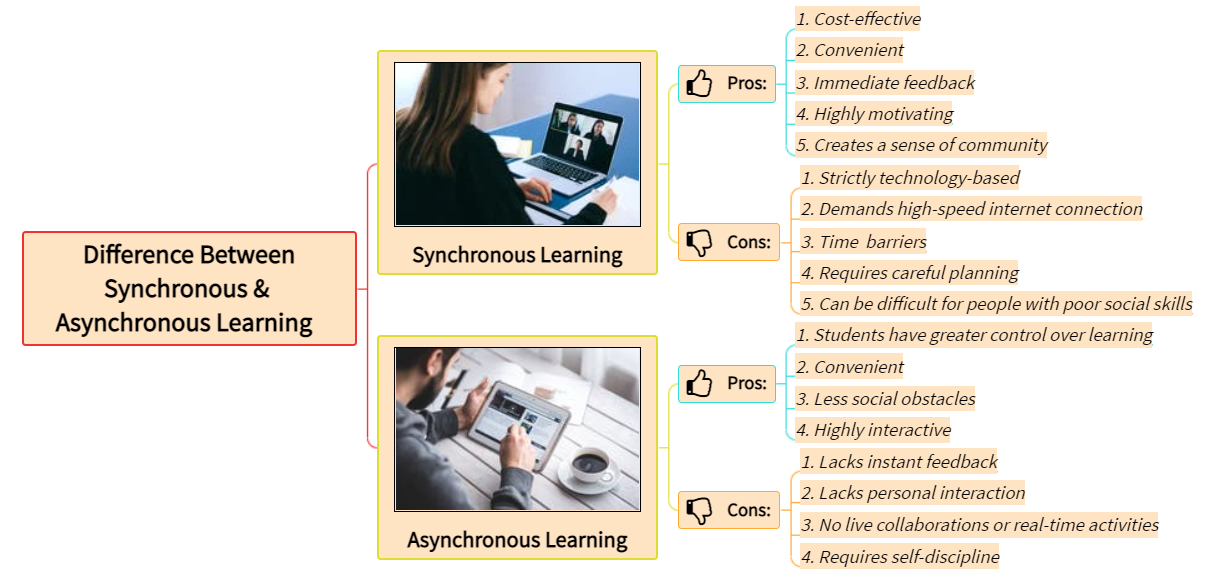Understanding Synchronous and Asynchronous Distance Learning Environments
As a school administrator, you may ask: What considerations should be given to choosing a distance learning program that is best for your school?
To better understand the process, it is essential to differentiate between synchronous and asynchronous learning.
SYNCHRONOUS LEARNING:
 Synchronous learning is a learning event when students are simultaneously learning together in a single focused environment.
Synchronous learning is a learning event when students are simultaneously learning together in a single focused environment.
Pros of Synchronous Learning
- Cost-Effective
- Convenient
- Provides Immediate Feedback
- Highly Motivating
- Creates a sense of community
Cons of Synchronous Learning
- Strictly technology-based
- Demands a high-speed internet connection
- Time barriers – can everyone be online at the same time?
- Requires careful planning
- Can be difficult for people with poor social skills
Synchronous Learning Examples:
Synchronous learning can prove more difficult for distance learning since it requires everyone to have access to the learning event via digital access. Utilizing interactive webinars, chat-based online discussions, or direct instruction lectures. Some of the virtual meeting tools such as Zoom, Google, or Skype are all appropriate methods for delivering distance learning content using the synchronous learning design, but this is not without faults. The scheduling and access to proper devices and bandwidth for all students can be problematic.
Furthermore, distance learning via synchronous learning requires a lot of people to align their schedules and can be prone to disruptions. Some educators might argue that this approach is still worth the added effort because students have real-time access to their instructors to ask questions, receive feedback, and they can interact with their peers in a virtual setting that allows for social interaction and may even improve mental health. While synchronous learning may be the best choice for some distance learning programs, asynchronous learning probably presents more pros and reasons for adopting.
ASYNCHRONOUS LEARNING:
 Asynchronous learning presents distance learning, using more one on one approach.
Asynchronous learning presents distance learning, using more one on one approach.
Pros of Asynchronous Learning
- Students have greater control over their learning
- Convenient
- Less social obstacles
- Highly interactive
Cons of Asynchronous Learning
- Lacks instant feedback
- Lacks personal interaction
- No live collaboration or real-time activities
- Requires self-discipline
Asynchronous Learning Examples:
Students have access to asynchronous learning content on their schedule.
Digital and online content is used to inform students through game-based learning tasks, pre-recorded video lessons, or other methods that are not presented in real-time. This approach means that students have access to their teachers via email exchanges, course-management systems, or online discussion boards, but it does not provide the real-time communication that synchronous learning provides; nonetheless, some people would argue that asynchronous learning is more engaging because of its interactivity. Students may enjoy the self-paced, highly scalable convenience that this form of distance learning provides. Practicing independently is another positive characteristic of asynchronous learning. This method makes access easier for all students, and it is less prone to distractions.
All in all, asynchronous learning yields many benefits.
What School Admins Should Consider Before Selecting a Distance Learning Program
When choosing an appropriate distance learning program, it is imperative to consider the school population.
- What is the average socioeconomic status of the school population?
- Will students need help acquiring devices and Internet connection?
- Are they able to log on at a controlled time, or would they benefit from a more flexible schedule?
Knowing the students is an integral part of choosing between synchronous or asynchronous learning options.
Click here to check some of the popular asynchronous & synchronous learning tools.







Pingback: 6 Most Popular Synchronous and Asynchronous Learning Tools for Distance Learning | Lumos Learning